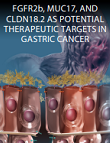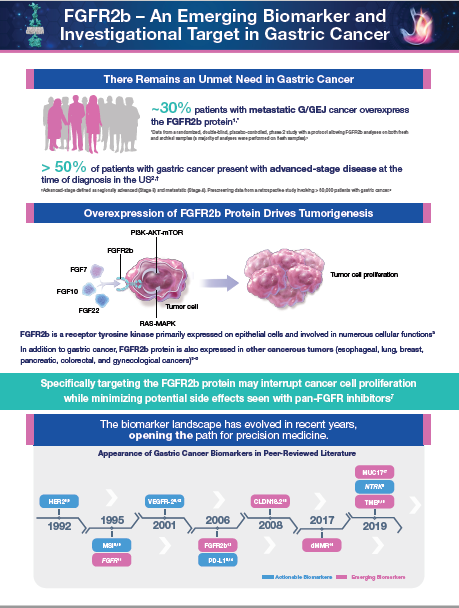
FGFR2b
Fibroblast growth factor receptor 2 (FGFR2) is one of four FGFR family members that encode transmembrane receptor tyrosine kinases. FGFR2b is the IIIb splice isoform of FGFR2.1
Expression of FGFRs and their corresponding ligands, fibroblast growth factors, contributes to tumor progression in human malignancies by enhancing angiogenesis and proliferation.2,3 Patients whose tumors have amplification of the FGFR2 gene tend to have a poor prognosis.4-7
In tumors with FGFR2 amplification, it is the FGFR2b splice variant that is almost invariably expressed on the cell surface.8-10
FGFR2b overexpression has been observed in approximately 30% of patients with advanced gastric and gastroesophageal junction cancer11 and has been reported in various other cancers as well,12-17 suggesting that targeting FGFR2b may be an important therapeutic strategy.
Learn more about modalities targeting FGFR2b:
monoclonal antibodies.



Search our clinical trials.
Visit our resources section for additional information on potential oncogenic targets.
1. Han N, Kim MA, Lee HS, Kim WH. Pathobiology. 2015;82(6):269-279. 2. Presta M, Dell’Era P, Mitola S, et al. Cytokine Growth Factor Rev. 2005;16(2):159-178. 3. Grose R, Dickson C. Cytokine Growth Factor Rev. 2005;16(2):179-186. 4. Ahn S, Lee J, Hong M, et al. Mod Pathol. 2016;29(9):1095-1103. 5. Su X, Zhan P, Gavine P, et al. Br J Cancer. 2014;110(4):967-975. 6. Seo S, Park S, Ryu M-H, et al. Oncotarget. 2017;8(20):33844-33854. 7. Jung E-J, Jung E-J, Min S, Kim MA, Kim WH. Hum Pathol. 2012;43(10):1559-1566. 8. Turner N, Grose R. Nat Rev Cancer. 2010;10(2):116-129. 9. Ornitz DM, Xu J, Colvin JS, et al. J Biol Chem. 1996;271(25):15292-15297. 10. Bai A, Meetze K, Vo NY, et al. Cancer Res. 2010;70(19):7630-7639. 11. Wainberg ZA, Enzinger P, Kang YK, et al. Presented at: ASCO Gastrointestinal Cancer Symposium; January 15-17, 2021; Online Virtual Scientific Program. Abstract LBA160. 12. Yoshino M, Ishiwata T, Watanabe M, et al. Int J Oncol. 2007;31(4):721-728. 13. Ishiwata T, Friess H, Büchler MW, Lopez ME, Korc M. Am J Pathol. 1998;153(1):213-222. 14. Kurban G, Ishiwata T, Kudo M, et al. Oncol Rep. 2004;11(5):987-991. 15. Yamayoshi T, Nagayasu T, Matsumoto K, et al. J Pathol. 2004;204(1):110-118. 16. Cho K, Ishiwata T, Uchida E, et al. Am J Pathol. 2007;170(6):1964-1974. 17. Watanabe M, Ishiwata T, Nishigai K, Moriyama Y, Asano G. Pathol Int. 2000;50(5):363-372.


















